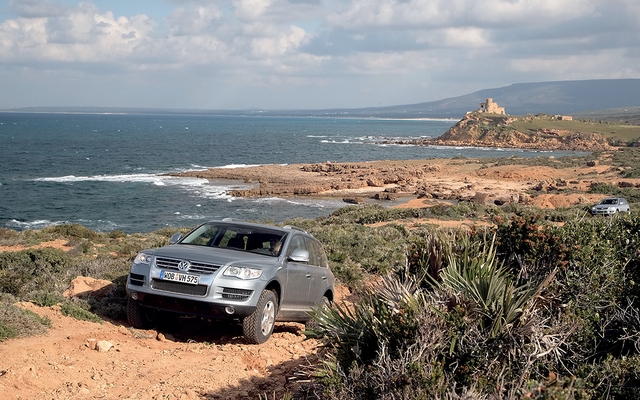2010 Volkswagen Touareg: A Bigger Beetle?

| Strong points |
|
|---|---|
| Weak points |
|
Volkswagen, when pronounced properly, is perhaps one of the easiest German-to-English translations extant. Trading the harsh English “v” for a softer “f” sound, you don’t need a degree in languages to understand what the term “folksvagen” means. A name birthed by none other than history’s most hated man, the brand’s first product was intended to give the citizens of the Third Reich a reliable means of transporting two adults and three children at speeds of up to 100 kilometres per hour. Eventually taking root internationally in a post-war boom, the equally appropriately named Beetle would grow to be the single most popular car in the world.
Which is precisely why, when Volkswagen introduced the Touareg SUV in 2002, critics were confused. Having built a long standing reputation for producing enjoyable, diminutive, economical cars, why Volkswagen would risk alienating their largest market in favour of the fickle and oft-hated sports-utility market proved beyond most peoples’ understanding. The result? Eight years and one revision later, the Touareg remains one of Volkswagen’s slowest selling vehicles. With just 880 examples finding loving homes last year, not even the addition of a thrifty turbodiesel V6 was enough to claw the Touareg’s sales out from the basement. Why?
After all, it’s certainly not an unattractive vehicle. Trimmed with Volkswagen’s uniquely subtle chrome trim and possessing of an overall shape that somehow retains Volkswagen-esque proportions, the Touareg looks handsomely understated next to many of the testosterone-fueled creations from other manufacturers. Sitting on massive 20” wheels and low profile tires, it’s a far cry from the burly off-road nature of Jeep’s various products, but looks at home parked outside even the classiest of restaurants. Out back, jumbo-sized taillights evoke nearly every Volkswagen wagon in recent memory, while the dual exhaust and substantial rear muffler (that is quite finely shaped and ribbed, I might add) hint at a high degree of engineering quality and design prowess.
Which is precisely what the Touareg possesses. Sharing its platform with Audi’s Q7 and Porsche’s Cayenne, its superstructure is obviously top-notch. Doors close with a refined and comforting thump, and the suspension, although being of the conventionally sprung variety in my tester, is independent and designed for use both on and off the road. Although I would hesitate to test its limits (and the resiliency of those low profile tires) in BC’s backcountry, the inclusion of a selectable low range in the transfer case gives me faith that this is one vehicle that should have no trouble in the coming winter months. Of course, the big news for this year was the addition of a 3.0 litre turbodiesel V6 underhood. Producing 221 horsepower and a whopping 407 pound feet of torque, the engine pulls like a proverbial freight train once the boost is on board, responding to the throttle almost as if it was unaware of the over two tons worth of vehicle strapped to it. As one would expect from such a performance-oriented wheel and tire package, the Touareg handles quite well, and the overall combination of the torque V6 and well-sorted suspension make it quite a pleasure on all but the most technical of roads.
But sadly, even the Touareg’s impressive performance isn’t enough to distract from its… well… dismal interior. Trimmed in a relatively attractive combination of grey, brown, and tan, it felt about as solid as one would expect an interior to feel, circa 2002. Because that’s precisely what it is. Although treated to a few so-mild-as-to-be-non-existent updates, the interior just feels lame. Although the new audio interface is a definite step in the right direction, the remainder of the controls are all of an extremely hard, extremely delicate-feeling plastic of the variety I’d expect to find on a pre-bankruptcy General Motors product. Furthermore, the placement of such controls as the 4WD system, HVAC, and the various (read: too many) steering wheel-mounted buttons is anything but intuitive. For example, the reverse parking warning system’s button is located next to the driver’s side seat heater dial, and takes up about four times for real estate than the rear defrost. The result? It’s too easy to turn off the parking system and too hard to turn on the rear defrost; a particularly bad combination. Then again, the odd placement of the ignition might preclude that particular dilemma from arising in the first place. If it doesn’t, you’ll surely be frustrated by the continuous rattle of your keychain against the dashboard as it’s absolutely impossible to avoid, which in turn may lead you to remove your Touareg’s key from the keychain, with the inevitable result that you’ll eventually lose said key. All in all, a bad design.
Which is, in my estimation, precisely why Volkswagen has sold just 880 Touareg’s last year. The slowest-selling vehicle in VW’s stable next to the impossible-to-find, but very desirable Eos convertible, the Touareg is shamed by even that beastly feat of badge engineering; the Routan. But perhaps the most telling figure is not the Touareg’s sales, but rather those of its smaller brother: the Tiguan. Proving that the market is clamouring for a proper Volkswagen SUV, over 5,075 buyers put Tiguans in their driveways last year. But there’s a light at the end of the tunnel for those that want the quality and excellence of design that’s earmarked Volkswagen designs since 1937, but need something bigger. Appearing later this year, the completely redesigned 2011 Touareg promises to address the concerns intrinsic in the current design, while adding a heap of style both inside and out. And although it probably won’t come close to shattering the Beetle’s sales record, I’d say that things are definitely looking up for the biggest VW.











